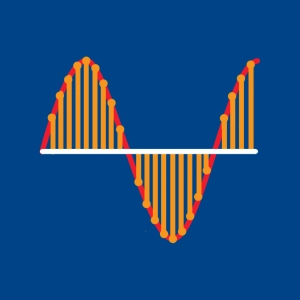 Video: Analog Digital Converter
Video: Analog Digital Converter
The red curve represents an analog signal. It is continuous. In passing from one value to another , the curve passes through all intermediate values.
The blue curve represents a digital signal. It is quantified, and so only certain values are accessible.
The digitization of an analog signal is carried out by taking several samples and translating them into binary code. The series of codes thus obtained are then regrouped in a digital file.
The advantage of such digitization lies in the ability of such file formats to undergo processing by a computer.
In order to obtain a digitization that corresponds to the original analog signal one must gain precision. To do this, it is sufficient to increase the sampling frequency
(…)
and decrease the pace of quantification. This has the effect of considerably increasing the size of the digital output file.
The Analog Digital Converter (ADC) is the name given the basic component that enables digitization to be carried out.
To give an example, an analog digital converter (8 bits, 100 MHz) generates a file of 100 MB every second. The processing system that follows must be capable of handling such a flood of data.
